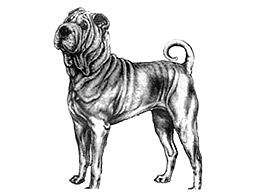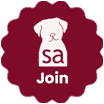Breed standards
Shar Pei
Breed standards are the official guidelines that describe the ideal characteristics, temperament, and appearance of a breed and ensures that the breed is fit for function with soundness essential.

Kennel Club, London 1994
KC amended June 1998
Effective in Australia January 2000
FCI Standard No 309
Alert, active, compact, short coupled, squarely built. Dogs larger and more powerful than bitches.
Relatively loose skin, frowning expression, harsh bristly.
Calm, independent, very affectionate, and devoted to people.
Relatively large but not disproportionate to the body, skull flat, broad, moderate stop. Length from nose to stop approximately equal to length from stop to occiput. Moderate wrinkle on forehead and cheeks. Muzzle moderately broad and full with no suggestion of tapering. The lips and top of muzzle may be slightly padded. When viewed from front, bottom jaw appears wider than top. Nose large, wide, preferably black but any colour conforming to general coat colour permissible.
Dark, medium size, almond shaped with frowning expression. Amber and lighter colour permissible in paler shades. Function of eyeball or lid in no way disturbed by surrounding skin, folds or hair. Any sign of irritation of eyeball, conjunctiva or eyelids highly undesirable. Free from entropion.
Very small, rather thick, equilaterally triangular in shape, slightly rounded at tip and set high on the skull with tips pointing towards eyes, set well forward over eyes, wide apart and close to skull. The tips and edges may turn up. Pricked ears highly undesirable.
Tongue, roof of mouth, gums and flews: solid bluish-black is preferred. Solid pink tongue undesirable. Dogs with self-coloured pigment and amber to light brown eyes would be expected to have a lavender tongue. Teeth strong, with a perfect, regular and complete scissor bite, i.e. the upper teeth closely overlapping the lower teeth and set square to the jaws. Padding of lower lip should not be so excessive so as to interfere with the bite.
Medium length, strong, full, set well on shoulders, with some loose skin under neck permitted, but this should not be excessive.
Shoulders muscular, well laid and sloping. Elbows close to body. Forelegs straight, moderate length, good bone; pasterns slightly sloping, strong and flexible. Forelegs completely free from wrinkle when mature.
Height at withers approximately equal to the length from point of shoulders to point of buttock. Depth of brisket approximately half of height at withers. Chest broad and deep, underline rising slightly under loin. Back short, strong. Topline dips slightly behind withers then rises over short, broad loin. Adult dogs should display moderate wrinkling over shoulders and base of tail. Excessive skin on body when mature highly undesirable.
Muscular, strong; moderately angulated; hocks well let down without excessive wrinkling or thickening.
Moderate size, compact, toes well knuckled.
Rounded, narrowing to fine point, base set very high. May be carried high and curved; carried in tight curl; or curved over. Lack of, or incomplete, tail highly undesirable.
Free, vigorous and balanced, rear single tracking is normal at a fast trot. Stilted gait undesirable.
Extremely harsh coat, straight and off-standing on the body but flatter on the limbs. No undercoat. Length varies from short and bristly, under 1.25 cm ( half an inch) or longer and thicker, between 1.25 cm ( half an inch) and 2.5 cm (one inch), but still off-standing and harsh to the touch.
N.B. No particular coat length within the accepted length should be preferred above the other. Never trimmed.
All solid colours except white are acceptable. Frequently shaded on tail and back of thighs with lighter colour.
Height: 46-51 cms (18-20 ins) at withers.
Any departure from the foregoing points should be considered a fault and the seriousness with which the fault should be regarded should be in exact proportion to its degree and its effect upon the health and welfare of the dog.
Male animals should have two apparently normal testicles fully descended into the scrotum.

